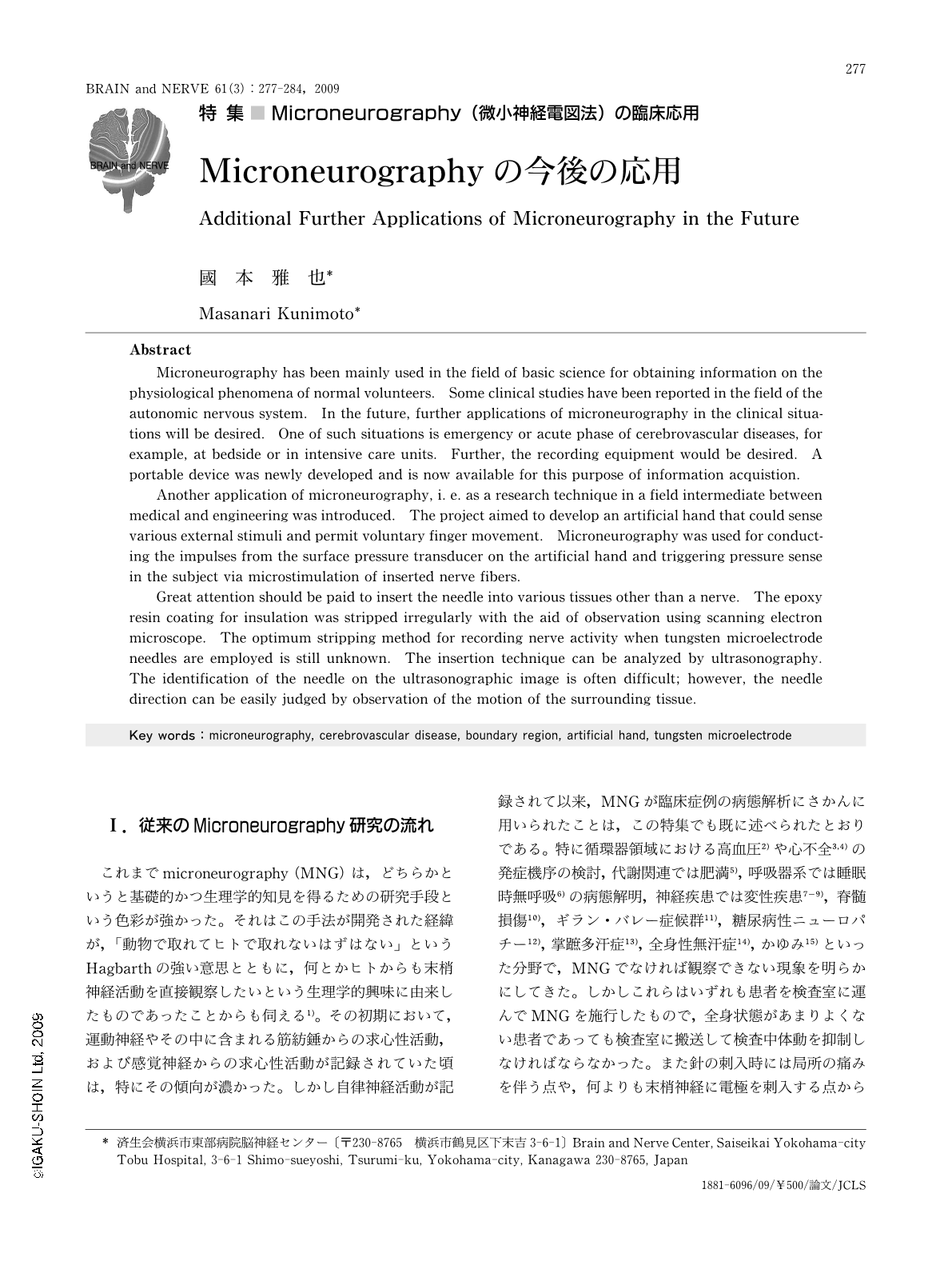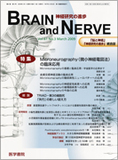Japanese
English
- 有料閲覧
- Abstract 文献概要
- 1ページ目 Look Inside
- 参考文献 Reference
Ⅰ.従来のMicroneurography研究の流れ
これまでmicroneurography(MNG)は,どちらかというと基礎的かつ生理学的知見を得るための研究手段という色彩が強かった。それはこの手法が開発された経緯が,「動物で取れてヒトで取れないはずはない」というHagbarthの強い意思とともに,何とかヒトからも末梢神経活動を直接観察したいという生理学的興味に由来したものであったことからも伺える1)。その初期において,運動神経やその中に含まれる筋紡錘からの求心性活動,および感覚神経からの求心性活動が記録されていた頃は,特にその傾向が濃かった。しかし自律神経活動が記録されて以来,MNGが臨床症例の病態解析にさかんに用いられたことは,この特集でも既に述べられたとおりである。特に循環器領域における高血圧2)や心不全3,4)の発症機序の検討,代謝関連では肥満5),呼吸器系では睡眠時無呼吸6)の病態解明,神経疾患では変性疾患7-9),脊髄損傷10),ギラン・バレー症候群11),糖尿病性ニューロパチー12),掌蹠多汗症13),全身性無汗症14),かゆみ15)といった分野で,MNGでなければ観察できない現象を明らかにしてきた。しかしこれらはいずれも患者を検査室に運んでMNGを施行したもので,全身状態があまりよくない患者であっても検査室に搬送して検査中体動を抑制しなければならなかった。また針の刺入時には局所の痛みを伴う点や,何よりも末梢神経に電極を刺入する点から侵襲性のある検査として位置付けられてきた。本特集の長谷川らの方法は他のものと違って電極が神経幹に刺入されるとすぐに記録できるので16),その探索に要する時間は短くて済むが,通常は神経幹に電極が刺入された後,そこから目的とする神経束あるいは単一の神経線維まで電極を微調整して移動させなければならず,これが検者には時間と労力を,そして被検者には忍耐を要するポイントである。また探索中皮下では電極の針先が見えない状況で操作を行っているので,神経以外の例えば血管に触れていることもあり得る。それは検査中においては,被検者が神経に触れたときとは違う痛みを訴えたり,検査終了後に電極を抜いた後刺入部位から出血を認めることで従来は確認されていた。以上の流れからすると,今後MNGのさらなる普及には,その機器の可搬性を高めることと,刺入から記録までの時間をいかに短縮し,被検者にとってはいかに安全で迅速に施行できるようになるかが求められていると言える。
Abstract
Microneurography has been mainly used in the field of basic science for obtaining information on the physiological phenomena of normal volunteers. Some clinical studies have been reported in the field of the autonomic nervous system. In the future, further applications of microneurography in the clinical situations will be desired. One of such situations is emergency or acute phase of cerebrovascular diseases, for example, at bedside or in intensive care units. Further, the recording equipment would be desired. A portable device was newly developed and is now available for this purpose of information acquistion.
Another application of microneurography, i. e. as a research technique in a field intermediate between medical and engineering was introduced. The project aimed to develop an artificial hand that could sense various external stimuli and permit voluntary finger movement. Microneurography was used for conducting the impulses from the surface pressure transducer on the artificial hand and triggering pressure sense in the subject via microstimulation of inserted nerve fibers.
Great attention should be paid to insert the needle into various tissues other than a nerve. The epoxy resin coating for insulation was stripped irregularly with the aid of observation using scanning electron microscope. The optimum stripping method for recording nerve activity when tungsten microelectrode needles are employed is still unknown. The insertion technique can be analyzed by ultrasonography. The identification of the needle on the ultrasonographic image is often difficult; however,the needle direction can be easily judged by observation of the motion of the surrounding tissue.

Copyright © 2009, Igaku-Shoin Ltd. All rights reserved.


